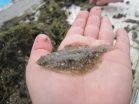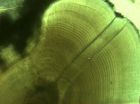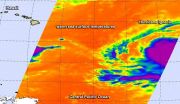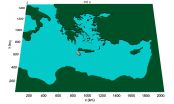(Press-News.org) DURHAM, N.H. - Researchers at the University of New Hampshire are turning to an unusual source --otoliths, the inner ear bones of fish -- to identify the nursery grounds of winter flounder, the protected estuaries where the potato chip-sized juveniles grow to adolesence. The research, recently published in the journal Transactions of the American Fisheries Society, could aid the effort to restore plummeting winter flounder populations along the East Coast of the U.S.
In addition to showing the age of a fish, much like the rings in the cross-section of a tree, otoliths carry the imprint of chemical elements found in a fish's watery surroundings. UNH graduate student David Bailey '13 and UNH faculty Elizabeth Fairchild (research assistant professor of biology) and Linda Kalnejais (assistant professor of oceanography) found that juvenile winter flounder from estuaries within 12 kilometers (about 7.5 miles) of each other share similar chemical "signatures" on their otoliths, influenced by unique geology and water chemistry from the watersheds that empty into estuaries.
Results from this study indicate that otolith chemistry can be used to trace juvenile winter flounder back to their brackish hometowns with 73% accuracy, offering scientists a new technological tool in their quest to monitor the species.
Winter flounder -- known on the menu as flounder, sole and lemon sole -- is a fishery valued at nearly $10 million in 2013. Yet their populations along the East Coast have plummeted in the last two decades, and despite strict regulations that have limited fishing pressure, their numbers are not rebounding, says Fairchild. Many estuaries, the nursery habitats of winter flounder, are experiencing warming waters and land development pressures that may affect the number of juveniles that can survive and make their way out to deeper offshore waters, she explains.
"We don't know where the adults actually come from, which specific bay," Fairchild says. "We wanted to know if we could say, yes, that's a Great Bay fish, or that's a Narragansett Bay fish, or a Boston Harbor fish. If we can figure that out, we can determine which estuaries in the Northeast are the most essential in terms of providing valuable habitat for winter flounder and protect those places."
"This research is important in terms of environmental protection, trying to figure out which estuaries are producing the most number of fish for the population where people can actually fish for them, and trying to protect those estuaries so we don't harm the winter flounder," Bailey adds. "You wouldn't want to dredge an area if you know that's the prime area that produces fish for a Gulf of Maine winter flounder fishery."
For this study, researchers collected otoliths from juvenile winter flounder at 12 locations in estuaries and shallow coastal waters ranging from the Navesink River in New Jersey northward to New Hampshire's Great Bay. Lead author Bailey, currently a research assistant at the Marine Biological Lab in Woods Hole, Mass., ran the samples through a mass spectrometer to determine the chemical make-up of otoliths from each location.
Juvenile winter flounder from the three study sites in N.H., including Great Bay, Little Harbor and Hampton-Seabrook Harbor, were able to be traced back to their nurseries with reasonable (73%) accuracy and had slightly different otolith chemistries among sites, despite the relative proximity of the estuaries to one another, Bailey says. Looking at the data on a larger scale, the research results indicated regional groupings for winter flounder stocks from Cape Cod, the Gulf of Maine and New Jersey.
Fairchild and Kalnejais recently received a research grant from NOAA's Saltonstall-Kennedy Grant Program that will extend their work to adult winter flounder. Collecting adult otoliths will help them make a definitive connection between estuaries and offshore stocks.
"There's a lot of money riding on what winter flounder are doing," Fairchild says. "Fishermen would like to see the stocks rebound so they can harvest them again. The Wampanoag Tribe on Martha's Vineyard would like to see them make a comeback because of the cultural importance this species has played in their history. The Army Corps of Engineers cannot dredge navigable water channels during several months each year when winter flounder eggs may be present."
INFORMATION:
Funding for this project was provided by New Hampshire Sea Grant, the Leslie S. Hubbard Marine Program Endowment of UNH's School of Marine Science and Ocean Engineering, and the UNH Graduate School.
N.H. Sea Grant promotes the wise use, conservation and sustainable development of marine and coastal resources in the state, the region and beyond. Located at the University of New Hampshire, NHSG is part of a national network of programs located in our coastal and Great Lakes states as well as in Puerto Rico and Guam.
The University of New Hampshire, founded in 1866, is a world-class public research university with the feel of a New England liberal arts college. A land, sea, and space-grant university, UNH is the state's flagship public institution, enrolling 13,000 undergraduate and 2,500 graduate students across three campuses.
Photographs available to download:
http://www.unh.edu/news/releases/2015/08/images/story-img-6flounder in hand.jpg
Juvenile winter flounder.
Credit: Dave Bailey.
http://www.unh.edu/news/releases/2015/08/images/img-6otolith cross-section.jpg/a>
Cross-section of a winter flounder inner ear bone, called an "otolith," that is used to determine age and origin of the fish.
Credit: Dave Bailey.
Media contacts: Beth Potier
UNH Research Communications
603-862-1566; beth.potier@unh.edu
@unhresearchnews
Rebecca Zeiber
N.H. Sea Grant
603-862-6704; rebecca.zeiber@unh.edu
@nhseagrant
When cloud top temperatures get colder, the uplift in tropical cyclones gets stronger and the thunderstorms that make up the tropical cyclones have more strength. NASA's Aqua satellite passed over Hurricane Ignacio and infrared data revealed cloud top temperatures had cooled from the previous day.
Ignacio strengthened to a hurricane at 11 p.m. EDT on August 26. It became the seventh hurricane of the Eastern Pacific Ocean hurricane season.
A false-colored infrared image of Hurricane Ignacio was made at NASA's Jet Propulsion Laboratory in Pasadena California, using data ...
Researchers from the Gladstone Institutes have revealed that HIV does not cause AIDS by the virus's direct effect on the host's immune cells, but rather through the cells' lethal influence on one another.
HIV can either be spread through free-floating virus that directly infect the host immune cells or an infected cell can pass the virus to an uninfected cell. The second method, cell to cell transmission, is 100 to 1000 times more efficient, and the new study shows that it is only this method that sets off a cellular chain reaction that ends in the newly infected cells ...
At a time when cancer drug prices are rising rapidly, an innovative new study provides the framework for establishing value-based pricing for all new oncology drugs entering the marketplace. Using a highly sophisticated economic model, researchers from Winship Cancer Institute of Emory University and Georgia Institute of Technology used an example of a new lung cancer drug. The study findings will be published August 27, 2015 in JAMA Oncology.
Researchers focused their investigation on a drug called necitumumab, which is awaiting approval from the U.S. Food and Drug ...
Use of the 21-gene recurrence test score was associated with lower chemotherapy use in high-risk patients and greater use of chemotherapy in low-risk patients compared with not using the test among a large group of Medicare beneficiaries, according to an article published online by JAMA Oncology.
National Comprehensive Cancer Network (NCCN) guidelines recommend considering chemotherapy in estrogen receptor (ER)-positive, node-negative breast cancer for all but the smallest tumors. Several studies have suggested the 21-gene recurrence score assay (testing) is cost-effective ...
Microfocused ultrasound (MFU) treatment to tighten and lift skin on the face and neck appeared to be safe for patients with darker skin types in a small study that resulted in only a few temporary adverse effects, according to a report published online by JAMA Facial Plastic Surgery.
Normal aging results in changes in the skin and underlying connective tissue. A system that uses MFU together with ultrasound visualization was developed to treat lax, aging skin. Previous clinical trials have shown the system to be a safe and effective noninvasive aesthetic treatment, according ...
PITTSBURGH, Aug. 27, 2015 - Researchers have identified in an animal model the molecular mechanisms behind resilience to noise-induced tinnitus and a possible drug therapy that could reduce susceptibility to this chronic and sometimes debilitating condition. The findings by a team from the University of Pittsburgh School of Medicine were published online in the journal eLife.
Tinnitus is typically induced by exposure to loud noise and causes whistling, clicking, roaring and other phantom sounds. It is estimated that 5 to 15 percent of Americans suffer from tinnitus, said ...
Each spring, powerful dust storms in the deserts of Mongolia and northern China send thick clouds of particles into the atmosphere. Eastward winds sweep these particles as far as the Pacific, where dust ultimately settles in the open ocean. This desert dust contains, among other minerals, iron -- an essential nutrient for hundreds of species of phytoplankton that make up the ocean's food base.
Now scientists at MIT, Columbia University, and Florida State University have determined that once iron is deposited in the ocean, it has a very short residence time, spending ...
Women lag behind men in the lucrative computer science and technology industries, and one of the possible contributors to this disparity is that they're less likely to enroll in introductory computer science courses.
A new study of 270 high school students shows that three times as many girls were interested in enrolling in a computer science class if the classroom was redesigned to be less "geeky" and more inviting.
The results, by University of Washington researchers, reveal a practical way for teachers to help narrow the gender gap in computer science by helping ...
About 10 percent of mothers experienced chronic, persistent depressive symptoms two years after Hurricane Katrina slammed into the Gulf Coast, killing more than 1,800 people, displacing hundreds of thousands and causing widespread damage estimated at more than $100 billion, according to a Georgia State University study.
While most people don't develop persistent depression after a major disaster like that, a small but significant number will, according to a study led by Dr. Betty S. Lai, assistant professor of epidemiology and biostatistics at the School of Public Health ...
A team of European researchers have developed a model to simulate the impact of tsunamis generated by earthquakes and applied it to the Eastern Mediterranean. The results show how tsunami waves could hit and inundate coastal areas in southern Italy and Greece. The study is published today (27 August) in Ocean Science, an open access journal of the European Geosciences Union (EGU).
Though not as frequent as in the Pacific and Indian oceans, tsunamis also occur in the Mediterranean, mainly due to earthquakes generated when the African plate slides underneath the Eurasian ...



